Forty-three years ago at this time, the Washington Capitals had just begun to take shape. Months away from playing the first game in franchise history, the Caps were comprised of a group of 25 young and unproven prospects chosen in the 1974 NHL Amateur Draft in May, and another group of two dozen players chosen in the 1974 NHL Expansion Draft on June 12, 1974.
Expansion Time Again
For the eighth time since joining the NHL as an expansion team in 1974, the Caps must expose some assets in another expansion draft.

By
Mike Vogel
WashingtonCaps.com
A cursory look at those two lists of players is all you need to understand how the Caps managed to win only eight of 80 games in their first season in the league.
The NHL swelled from six teams in 1966-67 to a dozen teams the next season. Two more clubs were added in 1970-71 and two more in 1972-73. The addition of the Capitals and the Kansas City Scouts for the 1974-75 campaign tripled the size of the NHL in less than a decade.
The rival World Hockey Association (WHA) took the ice for the 1974-75 season (the league's third season) with 14 teams, meaning there were 32 "major league" hockey teams in operation in North America at the outset of that season. Suddenly, there were more than 600 jobs available in major league hockey where there had been just over 100 less than a decade earlier. Europe was still a largely untapped market for hockey talent; of the 450 skaters who suited up for NHL duty in 1974-75, 406 were born in Canada and 30 hailed from the U.S.
The talent pool was severely diluted when Milt Schmidt and Scouts GM Sid Abel set about scouring the rosters of the existing 16 NHL clubs for whatever vestiges of talent they could find.
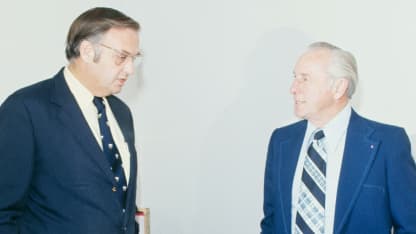
"It's not fair," Schmidt was quoted as saying in the June 11, 1974 edition of The New York Times. "We paid 6-million dollars to join the league and look how little the other teams have left for us."
The 16 existing clubs were each permitted to protect 15 skaters and a pair of goaltenders, and teams that lost goaltenders in the '72 expansion draft were exempt from losing another in 1974. Players whose first pro season was 1973-74 were also deemed draft exempt, and existing clubs were permitted to pull back a player each time they lost one. Each existing club would lose three players. So in effect, the Capitals and the Scouts were drafting the 16th, 18th and 20th best players from the existing clubs, and most of those existing clubs were facing an expansion draft for the third time in five years.
Of the 24 players Washington chose in the expansion draft, only three never played for the Capitals in a regular season NHL game. But only nine of the 24 played for Washington beyond the team's first dismal season in the league, and only three - goaltender Ron Low and defensemen Yvon Labre and Gord Smith - appeared in as many as 75 games as a member of the Capitals.
The NHL set the Caps and Scouts up for years and years of failure; the Caps missed the playoffs for the first eight seasons of their existence, and the KC franchise didn't win its first playoff series until 1988. The Scouts lasted two years in Kansas City before moving to Colorado in 1976 and then to New Jersey in 1982.
With Washington and Kansas City in the fold, the NHL had grown from six to 18 teams in less than a decade. The Caps have been involved in several expansions since then. Here's a quick look at how those prior expansions went for Washington.
1979 Expansion Draft
Before the league grew to 21 teams in 1979-80, it contracted to 17 teams. The Oakland Seals joined the NHL in 1967-68 along with five other teams in the league's first expansion, and the Seals were later redubbed the California Golden Seals. When the team failed to take hold in the Golden State, it moved to Cleveland for the '76-77 campaign.
After just two seasons, Cleveland "merged" with Minnesota after the 1977-78 season. Both franchises were on the verge of failure at that point, and the NHL operated with just 17 teams in 1978-79.
The process of adding the Edmonton, Hartford, Quebec and Winnipeg franchises from the WHA was intricate and convoluted; existing NHL teams were permitted to reclaim players lost to the renegade league over the years, and then the 17 NHL clubs were permitted to protect two goaltenders and 15 skaters as the four "new" teams restocked the remainder of their rosters.
Washington lost forward Blair Stewart to Quebec, it lost defenseman Gord Smith and forward Bill Riley to Winnipeg, and it lost forward Doug Patey to Edmonton.
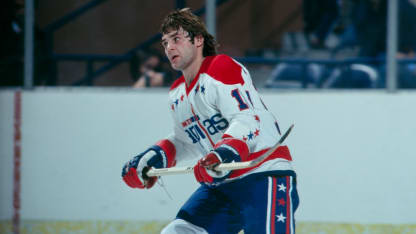
1991 Expansion Draft
More than a decade after growing to 21 teams, the NHL added another franchise for 1991-92 with the beginning of the San Jose Sharks. The Minnesota North Stars were still an unstable franchise a quarter of a century after starting their NHL life, and the Gund family that owned the team wanted to move the club to northern California. In order to prevent that, the NHL powers that be opted to expand, but also allowed the Gunds to take some players and some off-ice personnel with it to San Jose.
Essentially, the expansion draft was held to stock the remainder of the San Jose roster and to restock the North Stars after Minnesota lost a handful of its players to the Sharks.
Each of the other 20 existing NHL clubs was permitted to protect two goaltenders and 16 skaters, and each would lose exactly one player. First- and second-year pros were exempt, and each team had to expose at least one goaltender with at least 60 minutes worth of NHL experience. The existing clubs also had to expose at least one defenseman and at least one forward with at least 40 NHL games in the previous season or 70 NHL games over the previous two seasons.
Washington lost center Rob Murray in the 1991 Expansion Draft; he went to Minnesota with the 14th of 20 total picks. Murray had been the Caps' third round choice (61st overall) in the 1985 NHL Entry Draft.
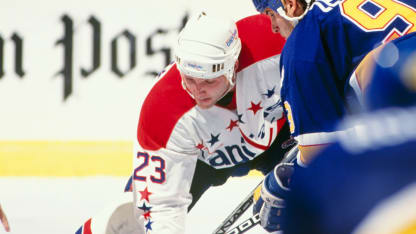
1992 Expansion Draft
The '92 expansion draft stocked new franchises in Ottawa and Tampa Bay. Rules were the same as the '91 Expansion Draft in terms of exposing experienced players, but this time around the existing teams were permitted to protect two goaltenders and only 14 skaters. The Sharks had played just one season in the league at this point, and they were exempt from losing players in the '92 Expansion Draft. Additionally, teams losing goaltenders or defensemen in the '91 draft would not need to expose players at those positions in '92.
The Lightning and Senators drafted 21 players each (two goalies, seven defensemen and a dozen forwards), and the existing teams did their best to mitigate losses, often resorting to devious tactics to do so.
Caps GM David Poile signed goalie Bernie Wolfe to contract with the intention of exposing him in the draft, despite the fact that Wolfe was 40 years old and hadn't played professionally for more than a decade. League commissioner John Ziegler stepped in and widely voided the Wolfe pact, realizing it as an attempt to skirt the rules. Poile signed veteran free agent goalie Steve Weeks and exposed him instead. Weeks went unclaimed in the draft, and the Caps traded him to Ottawa a couple months later.
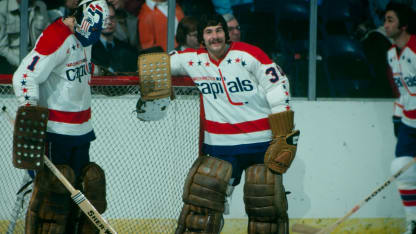
Washington exposed veteran defenseman and team captain Rod Langway in the '92 draft, but neither the Bolts nor the Sens took the Secretary of Defense. The Caps lost defenseman Shawn Chambers and forward Tim Bergland; both players went to Tampa Bay.
1993 Expansion Draft
When the league opted to expand to Anaheim and Florida for the 1993-94 season, its three most recent expansion teams - San Jose, Tampa Bay and Ottawa - were all still struggling mightily on the ice. With that in mind, existing teams were permitted to protect just one goaltender, along with nine forwards and five defensemen. First-year pros were exempt, but second-year pros were not, though the three recent expansion teams were exempt from losing second-year pros.
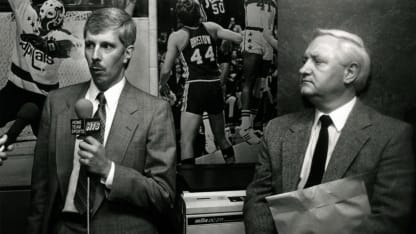
Additionally, each of the existing teams had to expose a goaltender on a pro contract as well as a defenseman and at least two forwards who played 40 NHL games in the previous season or 70 in the previous two campaigns.
The Anaheim and Florida franchises would draft three goalies, eight blueliners and 13 forwards, or one more player at each position than Ottawa and Tampa Bay had chosen a year earlier.
Existing teams could only lose one goalie or defenseman, and a team that lost a goaltender could not lose a defenseman. With these rules, six teams would lose a goalie and a forward, 16 would lose a defenseman and a forward, and two clubs would lose a pair of forwards.

In the days leading up to the '93 Expansion Draft, Capitals made a trio of minor deals designed to mitigate their losses. Poile obtained Kevin Kaminski from Quebec for Mark Matier, and five days later he got Mike Hough from Quebec for Reggie Savage and Paul MacDermid. Poile also sent Paul Cavallini to Dallas for future considerations, which turned out to be defenseman Enrico Ciccone.
In the end, the Caps lost Hough to Florida and Trevor Halverson to Anaheim. The Caps were one of the two teams to lose two forwards, a pretty good outcome for Washington.
1998 Expansion Draft
In 1998, the league added the Nashville Predators as its 27th team. The 26 existing teams were permitted to protect one goaltender, five defensemen and nine forwards, or they could protect two goaltenders along with just three defensemen and seven forwards. First- and second-year players were exempt, as were unsigned North American draft choices. European players chosen in the 1994 Entry Draft or earlier were subject to claim.
Nashville would draft 26 players, one from each team. The Preds had to take three goalies, eight defensemen and 13 forwards, plus two more players at whichever position Nashville desired.
A day ahead of a weeklong trade freeze in the league, the Caps dealt goaltender Bill Ranford to Tampa Bay for a third-round draft pick. Washington protected Olie Kolzig, and opted to get an asset for Ranford rather than lose him for nothing to Nashville.

Instead, the Caps lost forward Andrew Brunette to the Preds. Brunette is easily the best player Washington has ever lost in an expansion draft. The Caps' seventh-round choice (174th overall) in the 1993 NHL Entry Draft, Brunette totaled 18 goals and 40 points in just 62 games with the Caps, spread over parts of three seasons. Brunette totaled 11 goals and 23 points in 28 games with Washington in 1997-98, but Caps coach Ron Wilson was not enamored of Brunette's foot speed or his play in his own end of the ice.
Brunette lasted only one season in Nashville, but went on to play 1,110 games in the NHL. He finished with 268 career goals and 733 points, and he played for later expansion clubs in Atlanta and Minnesota.
The Caps protected nine forwards ahead of Brunette in 1998: Craig Berube, Peter Bondra, Joé Juneau, Steve Konowalchuk, Andrei Nikolishin, Adam Oates, Michal Pivonka and Chris Simon.
In hindsight, the Caps should have protected Brunette over Pivonka. The latter had an excellent career here in the District, but he was 32 years old and clearly on the downside when the Preds drafted their roster in June of 1998. Pivinka had totaled just 10 goals and 32 points in only 87 games over the prior two seasons, and his NHL career came to a halt after just 36 more games with Washington in 1998-99.
1999 Expansion Draft
The 1999 expansion brought the Atlanta Thrashers into the NHL as the league's 28th team. Clubs that lost goaltenders in the '98 draft weren't required to expose one in 1999, and aside from that, the rules were primarily the same.
The Caps lost veteran defenseman Mark Tinordi to the Thrashers in that '99 draft. Tinordi, a rock on the Washington blueline for several seasons, was an impending unrestricted free agent that summer. In those days, teams losing players to unrestricted free agency were compensated with draft choices, and the more money the player signed for, the better the draft choice.
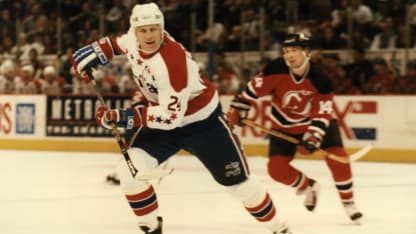
Unfortunately for Atlanta, Tinordi never signed with any team and never played another game in the NHL. The bruising blueliner suffered a season-ending ankle injury in February of 1999, and it ultimately turned out to be a career-ending injury. Washington got out of that 1999 Expansion Draft unscathed.
2000 Expansion Draft
Columbus and Minnesota joined the Original 30 for the 2000-01 season, and the 2000 Expansion Draft stocked those two clubs. The rules were the same as in 1998 and 1999, with both Nashville and Atlanta exempt. Columbus and Minnesota would each start out with 26 players, and each of the existing clubs aside from the Preds and Thrashers would lose two players each.
Washington breezed through this expansion draft, losing defenseman Oleg Orekhovsky to Minnesota and forward Barrie Moore to Columbus.
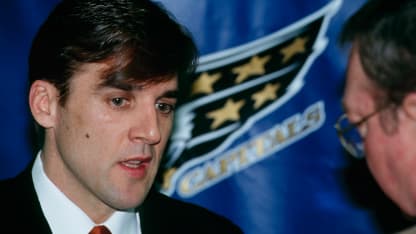
Orekhovsky was an eighth-round pick (206th overall) from the 1996 NHL Entry Draft; he never played in North America but was a fixture for a decade and a half in Russia's top league. Moore was a former Sabre and Oiler who played in just one game as a Capital. He came to Washington in a Feb. 1999 deal with the Oilers, a swap in which former first-rounder Brad Church went to Edmonton.
There you have it. That's the history of the Caps' involvement in NHL expansion drafts from 1974 to now, with an additional chapter waiting to be written next week when the Capitals lose a player to the Vegas Golden Knights, the league's 31st team.
Note: The primary source for this piece is deep and rich blog site
http://historicalhockey.blogspot.ca
, where you'll find a tremendous wealth of resources and information relating to NHL drafts of all kinds, including the now defunct waiver draft. I offer profound thanks to Mark Parsons, who did a staggering amount of research in building that valuable resource. Not only does it contain lists of protected and exposed players from past expansion drafts, it also includes a list of trades made in the league immediately before and after those drafts. It's a great rabbit hole to wander down anytime you've got a few hours to kill and a little thirst for a lot of knowledge.


















